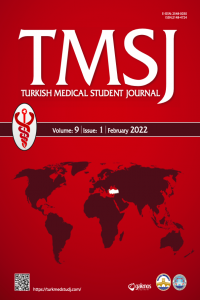A CASE REPORT: THE ROLE OF PROSTATE-SPECIFIC MEMBRANE ANTIGEN LABELED THERANOSTIC AGENTS IN THE DIAGNOSIS AND TREATMENT OF PROSTATE CANCER
A CASE REPORT: THE ROLE OF PROSTATE-SPECIFIC MEMBRANE ANTIGEN LABELED THERANOSTIC AGENTS IN THE DIAGNOSIS AND TREATMENT OF PROSTATE CANCER
Aims: Prostate cancer is one of the most prevalent cancers worldwide and sometimes it can be deadly which brings out a high quantity of the prostate specific membrane antigen. Gallium-68 prostate specific membrane antigen PET scan is used to detect primary tumors and metastases of prostate cancer. In addition, Lutetium-177 prostate-specific membrane antigen is used for treatment in some special cases. Our case report aims to show the roles of prostate specific membrane antigen labeled theranostic agents in the diagnosis, staging, and treatment of prostate cancer and evaluate the response to the treatment of metastatic castration-resistant prostate cancer. Case Report: A 78-year-old male patient was admitted to Trakya University Hospital Nuclear Medicine Department with the diagnosis of prostate cancer for cancer staging and treatment. Gallium-68 prostate specific membrane antigen was firstly used to detect any metastases and then to evaluate response to the treatment. Lutetium-177 prostate specific membrane antigen was used for treatment. Conclusion: After 3 cures of Lutetium-177 therapy, the patient underwent Gallium - 68 prostate specific membrane antigen PET which demonstrated regression of the metastatic tumor. There was a decrease in the uptake of Gallium-68 prostate specific membrane antigen in the primary tumor and lymph nodes metastases. Also, bone metastases have been cleared. Hence, Lutetium-177 seems to be a promising treatment modality to treat metastatic prostate cancer.
Keywords:
Prostate cancer, theranostic, lutetium,
___
- 1. Mottet N, Bellmunt J, Briers E et al. Guidelines on prostate cancer, 2015. Available from: URL: https:// uroweb.org/wp-content/uploads/09-Prostate-Cancer_ LR.pdf.
- 2. American Cancer Society. Cancer facts & figures 2018. Available from: URL: https://www.cancer. org/content/dam/cancer-org/research/cancer-facts-and-statistics/annual-cancer-facts-and-figures/2018/cancer-facts-and-figures-2018.pdf.
- 3. Crawford ED, Petrylak D, Sartor O. Navigating the evolving therapeutic landscape in advanced prostate cancer. Urol Oncol 2017;35:1-13.
- 4. Teo MY, Morris MJ. Prostate-specific membrane antigen-directed therapy for metastatic castration-resistant prostate cancer. Cancer J 2016;22(5):347-52.
- 5. Giesel FL, Fiedler H, Stefanova M et al. PSMA PET/ CT with Glu-urea-Lys-(Ahx)-[⁶⁸Ga (HBED-CC)] versus 3D CT volumetric lymph node assessment in recurrent prostate cancer. Eur J Nucl Med Mol Imaging 2015;42(12):1794-800.
- 6. Afshar-Oromieh A, Avtzi E, Giesel FL et al. The diagnostic value ofPET/CT imaging with the (68) Ga-labelled PSMA ligand HBED-CC in the diagnosis of recurrent prostate cancer. Eur J Nucl Med Mol Imaging 2015;42(2):197-209.
- 7. Durmuş Altun-Üstün (2017) Nükleer Tıp Görüntüleme Teknikleri Ders Kitabı: Nobel Tıp Kitapevleri, 2017.
- 8. Emmett L, Willowson K, Violet J et al. Lutetium 177 PSMA radionuclide therapy for men with prostate cancer: a review of the current literature and discussion of practical aspects of therapy. J Med Radiat Sci 2017;64(1):52-60.
- 9. Udovicich C, Perera M, Hofman M et al. 68Ga-prostate-specific membrane antigen-positron emission tomography/computed tomography in advanced prostate cancer: current state and future trends. Prostate International 2017;5(4):125-9.
- 10. Ahmadzadehfar H, Wegen S, Yordanova A et al. Overall survival and response pattern of castration-resistant metastatic prostate cancer to multiple cycles of radioligand therapy using [177Lu]Lu-PSMA. Eur J Nucl Med Mol Imaging 2017;44(9):1448-54.
- 11. Rauscher I, Maurer T, Fendler WP et al. 68Ga-PSMA ligand PET/CT in patients with prostate cancer: how we review and report. Cancer Imaging 2016;16:14.
- 12. Kabasakal L, Toklu T, Yeyin N. Lu-177-PSMA-617 prostate-specific membrane antigen inhibitor therapy in patients with castration-resistant prostate cancer: stability, bio-distribution and dosimetry. Mol Imaging Radionucl Ther 2017;26(2):62-8.
- ISSN: 2148-4724
- Başlangıç: 2014
- Yayıncı: Trakya Üniversitesi
Sayıdaki Diğer Makaleler
Ali Rıza AVUL, Büşra ÖZDEMİR, Gülay Durmuş ALTUN
CAENORHABDITIS ELEGANS AND ANGIOGENESIS
İbrahim KILIÇÇALAN, Abdulbaki ERKOVAN, Emine ŞEN
AN INVESTIGATION ON THE ANTICANCER EFFECT OF SPIDER WEB IN HUMAN CERVICAL CELL LINE
Aslı Nur ÖZKAN, Oğuzhan DOĞANLAR
EVALUATION OF MALNUTRITION STATUSES IN SYSTOLIC HEART FAILURE PATIENTS
İrmak İrem ÖZYİĞİT, Beliz KOÇYİĞİT, Begüm SÖYLEYİCİ, Fatih Mehmet UÇAR
THE INFLUENCE OF INTERCURRENT DISEASES ON THE COURSE OF HIV IN ASSOCIATION WITH ACTIVE TUBERCULOSIS
Tetiana Kolotylo, Hennadii PETROCHENKOV, Orest GRİTSİUK
SYSTEMIC CANNABIDIOL DOES NOT REDUCE COMPOUND 48/80-INDUCED ITCHING BEHAVIOR IN MICE
Hatice Demirel, Elif Baksın, Ece Önay Özgür, Ruhan Deniz Topuz, Ahmet ULUGÖL
